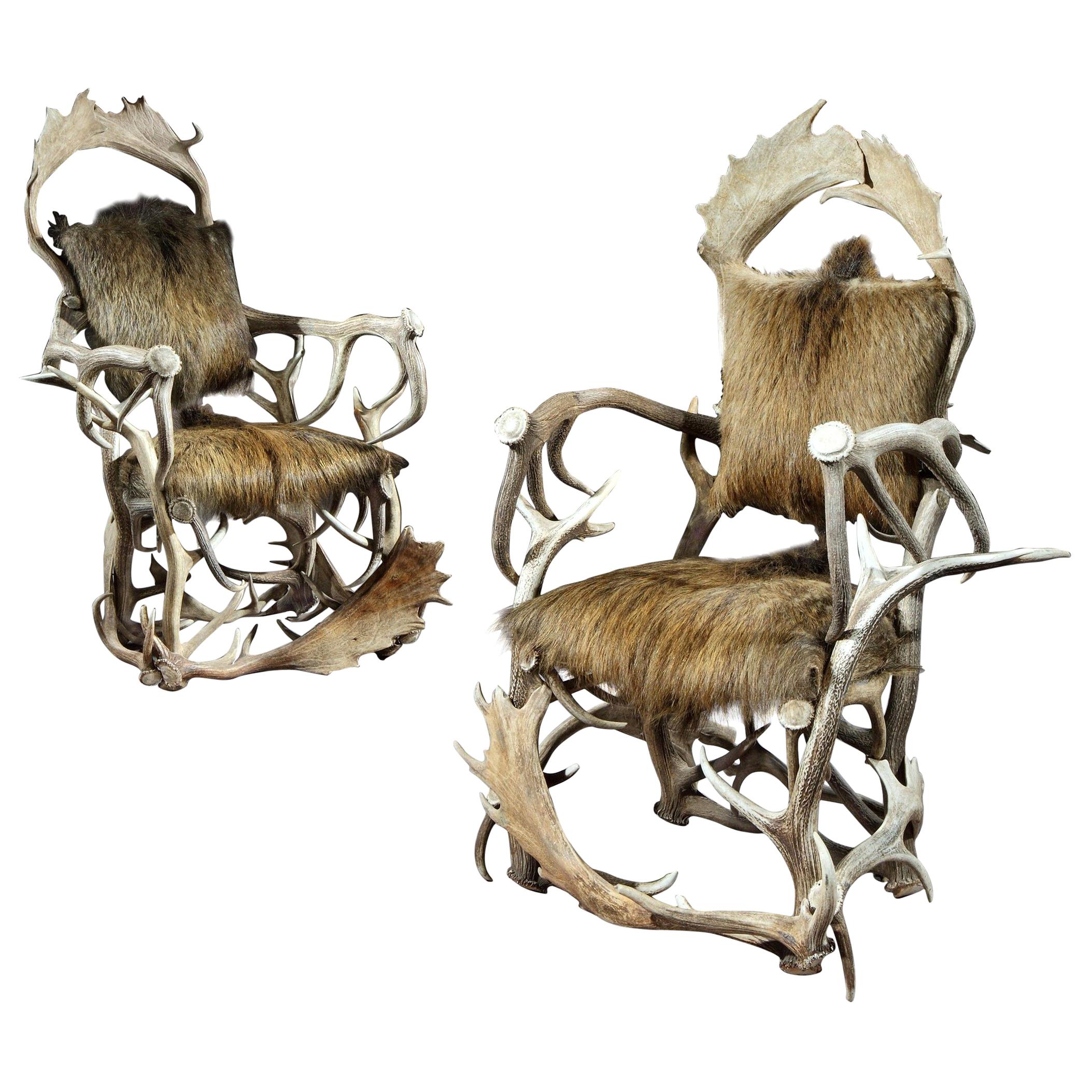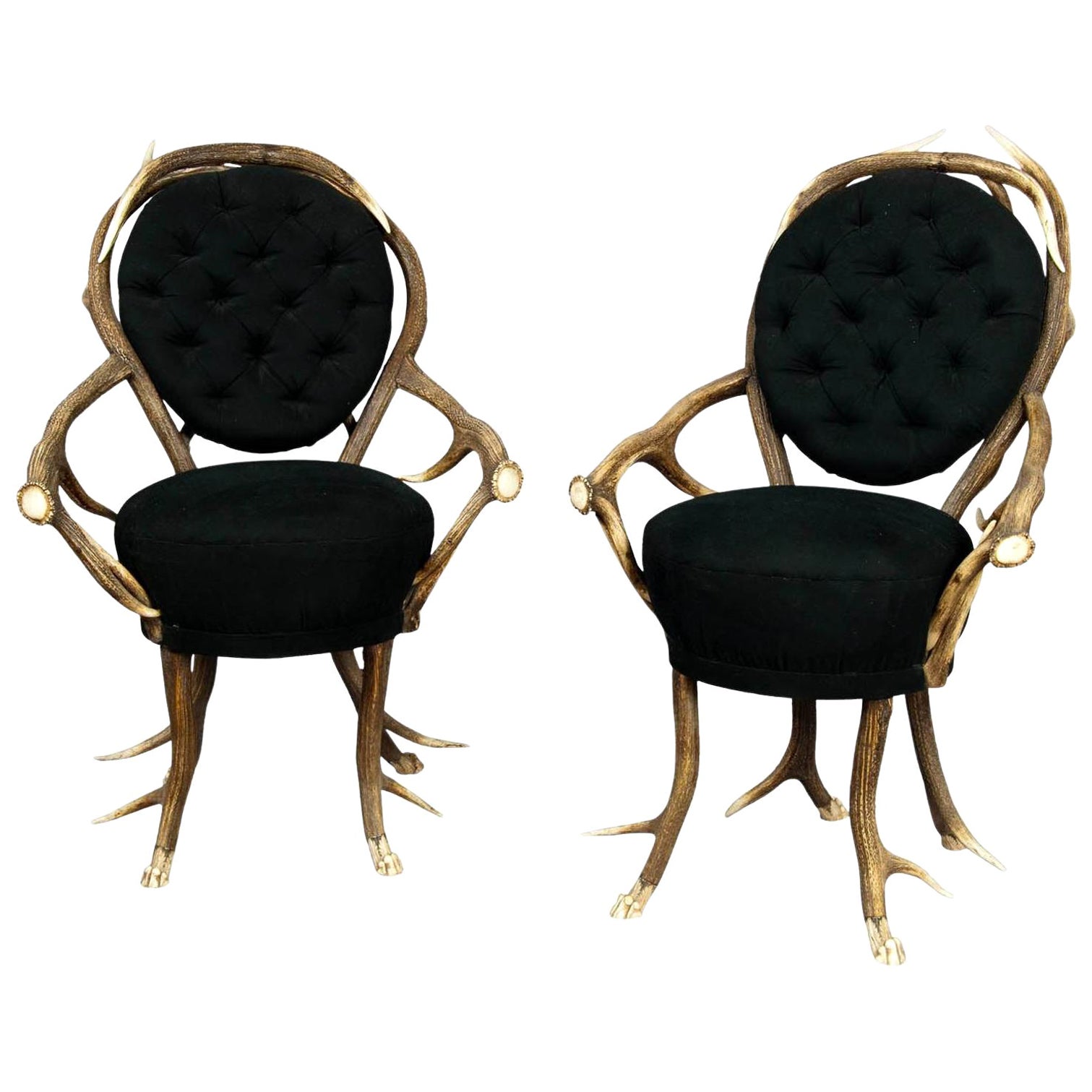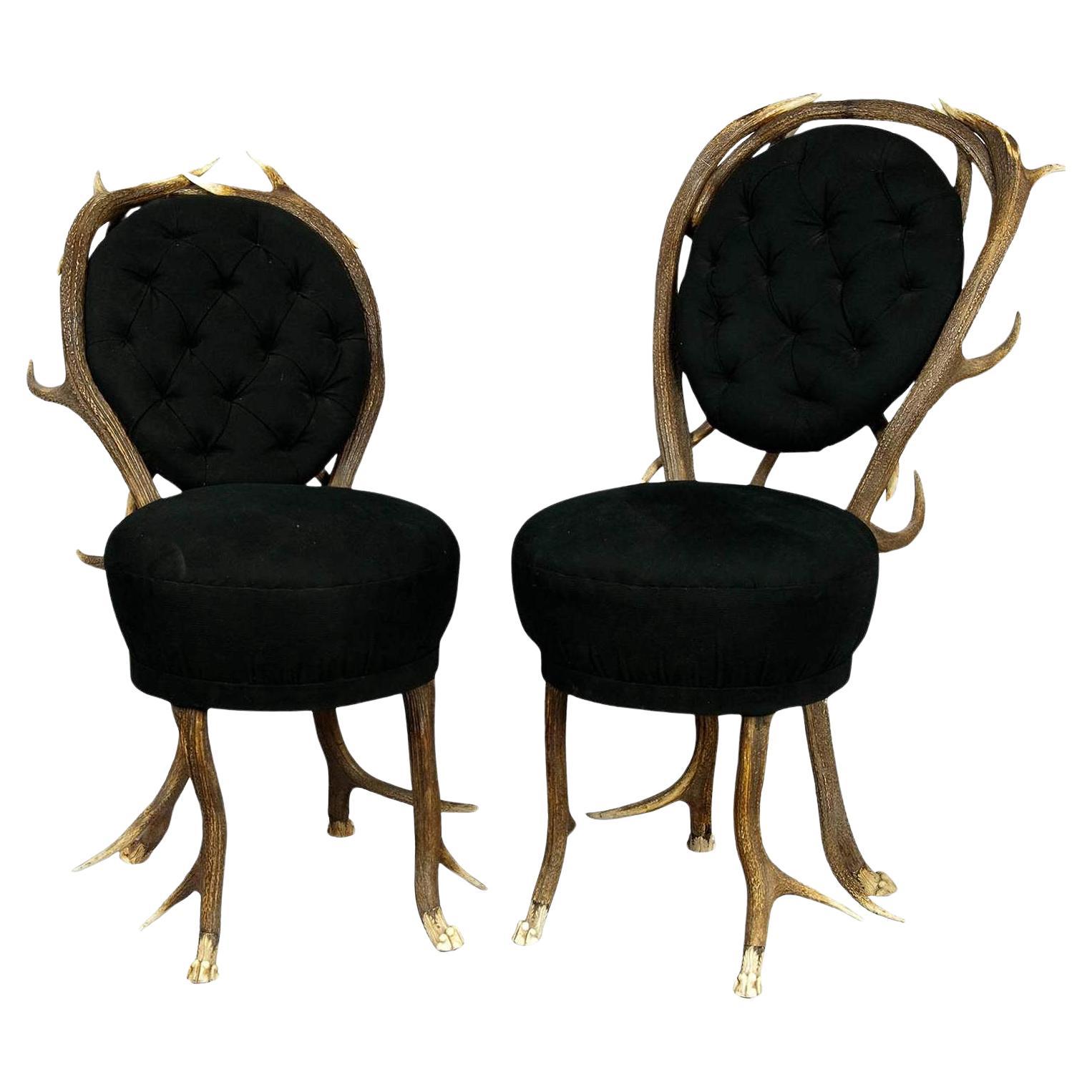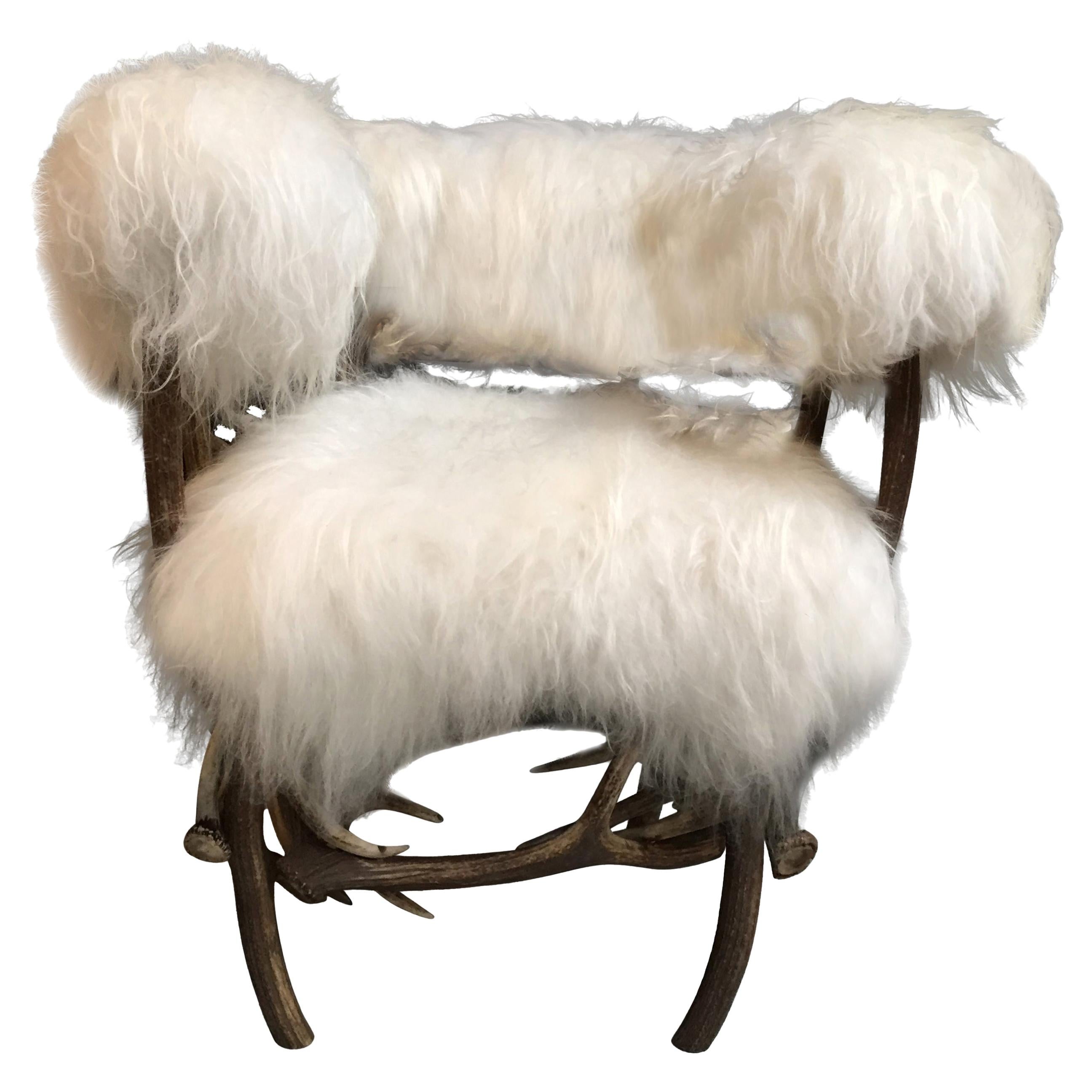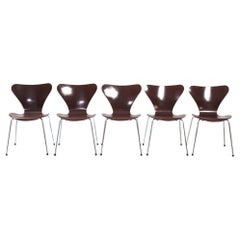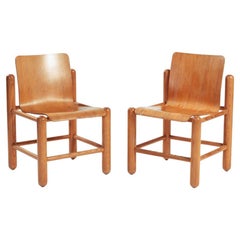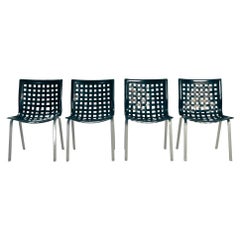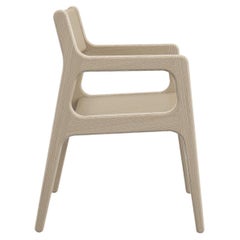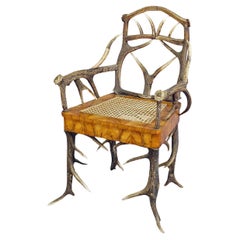Items Similar to Wildboar chair, Armchair Hunting Trophy, Antler, Red Deer, Fallow, Hide
Want more images or videos?
Request additional images or videos from the seller
1 of 21
Wildboar chair, Armchair Hunting Trophy, Antler, Red Deer, Fallow, Hide
About the Item
Hunting trophy armchair of antlers, wild boar and red deer. Very expressive and impressive looking throne
The fluid form of the antlers creates a sculptural, organic aesthetic.
Next to that this chair is usable and comfortable. It has taken great skill to make these chairs, selecting massive antlers to create exquisite form and stability within a minimalistic, sculptural aesthetic.
The impressive crestings, sides and front stretchers on each armchair are made from five magnificent fallow deer antlers. The arms and supports on each chair are made from massive red deer antlers. The antlers are arranged creatively to create both, a stable structure and sculptural form. The seats are upholstered in wild boar hide.
Measurements: h 146, d 95, w 135 cm
Seating height 47 cm
Museums With Collections of Antler Furniture:
• Victoria & Albert Museum, London
• Museum casle trautenfels, Trautenfels – Austria
• Museum of natural history, Venice
• Palace Museum, Beijing
“There is grace and movement in the antler itself. They’re one of the most beautiful forms in nature…” Gail Flynn
Hunting trophies have been used as source material for clothes hooks, storage racks and lamps since the 15th century. Mounting antlers and stuffed heads on walls provided impressive, decorative displays for hunting trophies. A hunting lodge replete with antlers and stuffed animals was most likely where ideas for antler furnishings emerged.
At the beginning of the 19th century antler furniture was made exclusively for the European nobility to decorate palaces, castles and country seats. The furniture was either made completely from stag antler, or it was decorated with antler pieces from the stag, deer, fallow deer and others, or veneered with sliced antler pieces to create a hunting design.
The first recorded antler furniture dates from 1825, made for a hunting castle of Count William of Nassau near Wiesbaden, Germany. Other famous collections of historical antler furniture are the hunting room in the country estate of the brandhof of Archduke Johann of Austria or the antler collection of Count Arco in his palace in Munich, Germany. There are hundreds of drawings of creative antler decorations by the Austrian furniture maker Joseph Danhauser (1780-1829).
In 1851, chairs, chests of drawers and a sofa made of horns were exhibited at the Great Exhibition Of The Industries Of All Nations in London which were considered one of the great novelties of this iconic exhibition. This created a new lifestyle trend and fashion driven by the ambitious European middle-class and antler furniture disseminated into bourgeoisie households. One of the first designers is the German ivory carver and furniture maker H. F. C. Rampendahl who gained enthusiastic successes on several world exhibitions with his antler furniture. An antler bureau, a horn seating group or individual chairs, decorated gun cabinets, H.F.C. Rampendahl created a whole new design world for fashioning rooms. This prompted other designers in Germany Austria and USA to make antler furniture H.F.C. Rampendahl, Hamburg, P. Keutner, Regensburg, Vitus Madel & Son, Ichenhausen, Kurt Schicker, Regensburg, Heinrich Keitel, Vienna, Rudolf Brix, Vienna, Friedrich Wenzel, San Antonio. These are some of the most important manufacturers of antler furniture and their range covered the whole market of furniture as well as smaller pieces. Their catalogues feature antler furnishings (Geweihmöbel) like antler gun racks, antler chandeliers, antler-frames, antler chairs, lusterweibchen, antler cabinets as well as small decorative items like desk sets, humidors, wardrobes, cutlery, etc..
The last decade has seen a revival in the popularity of antler furniture. Its iconic, natural organic style creates a striking focal point in modern households as well as eye-catchers for hunting lodges and chalets in mountain areas. The flowing sculptural form of antlers retain the grace, agility and presence of the animals that they came from.
Provenance: Private Collection
Literature: • Georg Olms: August Stukenbrok Illustrierter Hauptkatalog. Olmspresse, Hildesheim 1972
• Sabine Spindler: Geweihmöbel 1825-1925. Klaus Spindler, München 2006
• Bruce M. Newman: Fantasy Furniture. Rizzoli, New York 1989
• Christopher Payne: 19th CENTURY EUROPEAN FURNITURE Antique Collectors´ Club, England 1981
• Rainer Haaff: Prachtvolle Stilmöbel Kunst-Verlag-Haaff 2012
• Richard St.John, Longhorn Artist: Wenzel, Friedrich (Wichita State University Office of Research and Sponsored Programs, 1982).
- Dimensions:Height: 57.49 in (146 cm)Width: 53.15 in (135 cm)Depth: 37.41 in (95 cm)Seat Height: 18.51 in (47 cm)
- Style:Black Forest (In the Style Of)
- Materials and Techniques:
- Place of Origin:
- Period:
- Date of Manufacture:Unknown
- Condition:
- Seller Location:Zevenaar, NL
- Reference Number:1stDibs: LU9519239637922
About the Seller
No Reviews Yet
Vetted Seller
These experienced sellers undergo a comprehensive evaluation by our team of in-house experts.
1stDibs seller since 2023
8 sales on 1stDibs
Typical response time: 3 hours
- ShippingRetrieving quote...Ships From: Zevenaar, Netherlands
- Return PolicyA return for this item may be initiated within 14 days of delivery.
Authenticity Guarantee
In the unlikely event there’s an issue with an item’s authenticity, contact us within 1 year for a full refund. DetailsMoney-Back Guarantee
If your item is not as described, is damaged in transit, or does not arrive, contact us within 7 days for a full refund. Details24-Hour Cancellation
You have a 24-hour grace period in which to reconsider your purchase, with no questions asked.Vetted Professional Sellers
Our world-class sellers must adhere to strict standards for service and quality, maintaining the integrity of our listings.Price-Match Guarantee
If you find that a seller listed the same item for a lower price elsewhere, we’ll match it.Trusted Global Delivery
Our best-in-class carrier network provides specialized shipping options worldwide, including custom delivery.More From This Seller
View AllArne Jacobsen for Fritz Hansen, serie 7 Butterfly chairs
By Arne Jacobsen, Fritz Hansen
Located in Zevenaar, NL
Set of 5 all original early 7 series chairs of Fritz Hansen designed by Arne Jacobsen.
In its original colour chocolate brown, with some small traces of use according to age.
No cra...
Category
Vintage 1960s Danish Mid-Century Modern Chairs
Materials
Steel
$1,457 Sale Price / set
20% Off
Violin shaped chairs by Maroeshka Metz, Dutch pomo design, 1980s
Located in Zevenaar, NL
Dutch designer Maroeska Metz was educated as a sculptor at Gerrit Rietveld Academy Amsterdam.
Characteristic of her works is that all her works are swirl...
Category
Vintage 1980s Dutch Post-Modern Chairs
Materials
Steel
Knud Friis & Elmar Moltke Nielsen (Friis & Moltke) pine brutalist chairs Getama
By Knud Friis & Elmar Moltke Nielsen
Located in Zevenaar, NL
Set of two very rare comfort Solid Wood Chairs by Brutalist architects Knud Friis and Elmar Moltke Nielsen.
Denmark 1970s.
Handmade bent...
Category
Mid-20th Century Brutalist Chairs
Materials
Pine, Plywood
Black leather dining net chairs by Giancarlo Vegni for Fasem Italy
By Giancarlo Vegni
Located in Zevenaar, NL
Set of 4 Italian Lounge dining chairs also called Net chair with steel steel structure, original laquered in grey and continuous seat/back made of interlaced stripes of full grain hi...
Category
20th Century Italian Chairs
Materials
Metal
$3,832 Sale Price / set
20% Off
Free Shipping
Egon Eiermann for Wilde & Spieth, SE68 Bauhaus chair set of 13
By Egon Eiermann, Wilde + Spieth
Located in Zevenaar, NL
Stackable SE68 Chair by German architect Egon Eiermann for Wilde & Spieth in red.
Designed in 1952.
Ergonomic & organically shaped beech plywood seat and backrest, frame made of chr...
Category
Vintage 1950s German Bauhaus Chairs
Materials
Metal
$6,887 Sale Price / set
20% Off
MG5 s34Bauhaus cantilever black leather chairs by Fasem Italy, 1980s
By Mart Stam, Fasem International, Marcel Breuer
Located in Zevenaar, NL
Set of 5 mg5 5 "S34" Mart Stam/ Marcel Breuer tubular frame chairs, Fasem Italy
How timeless something can be! This design by Mart Stam is originally from the 1920s and completely m...
Category
20th Century Italian Bauhaus Chairs
Materials
Steel, Chrome
$3,576 Sale Price / set
24% Off
You May Also Like
Armchair, Pair, Hunting Trophy, Antler, Red Deer, Fallow, Wild Boar, Hide
Located in BUNGAY, SUFFOLK
Pairs of hunting trophy armchairs are exceptionally rare. This pair are also unusual because they are made from a few large antlers giving them a minimalist quality. The fluid form of the antlers creates a sculptural, organic aesthetic. They are also usable and very comfortable. It has taken great skill to make these chairs, selecting massive antlers to create exquisite form and stability within a minimalistic, sculptural aesthetic. They are dramatic and unusual injecting a naturalistic and organic gravitas to any interior which reflects the grace, agility and presence of the kings of forest that they came from.
The impressive crestings, sides and front stretchers on each armchair are made from five magnificent fallow deer antlers. The arms and supports on each chair are made from eight massive red deer antlers. The antlers are arranged creatively to create both, a stable structure and sculptural form. The seats are upholstered in wild boar hide.
Dimensions: Width 91cm., 35.83in., Height 132cm., 51.97in., Depth 96cm., 37.80in.
Museums With Collections Of Antler Furniture
• Victoria & Albert Museum, London
• Museum casle trautenfels, Trautenfels – Austria
• Museum of natural history, Venice
• Palace Museum, Beijing
“There is grace and movement in the antler itself. They’re one of the most beautiful forms in nature…” Gail Flynn
Hunting trophies have been used as source material for clothes hooks, storage racks and lamps since the 15th century. Mounting antlers and stuffed heads on walls provided impressive, decorative displays for hunting trophies. A hunting lodge replete with antlers and stuffed animals was most likely where ideas for antler furnishings emerged.
At the beginning of the 19th century antler furniture was made exclusively for the European nobility to decorate palaces, castles and country seats. The furniture was either made completely from stag antler, or it was decorated with antler pieces from the stag, deer, fallow deer and others, or veneered with sliced antler pieces to create a hunting design.
The first recorded antler furniture dates from 1825, made for a hunting castle of Count William of Nassau near Wiesbaden, Germany. Other famous collections of historical antler furniture are the hunting room in the country estate of the brandhof of Archduke Johann of Austria or the antler collection of Count Arco in his palace in Munich, Germany. There are hundreds of drawings of creative antler decorations by the Austrian furniture maker Joseph Danhauser (1780-1829).
In 1851, chairs, chests of drawers and a sofa made of horns were exhibited at the Great Exhibition Of The Industries Of All Nations in London which were considered one of the great novelties of this iconic exhibition. This created a new lifestyle trend and fashion driven by the ambitious European middle-class and antler furniture disseminated into bourgeoisie households. One of the first designers is the German ivory carver and furniture maker H. F. C. Rampendahl who gained enthusiastic successes on several world exhibitions with his antler furniture. An antler bureau, a horn seating group or individual chairs, decorated gun cabinets, H.F.C. Rampendahl created a whole new design world for fashioning rooms. This prompted other designers in Germany Austria and USA to make antler furniture H.F.C. Rampendahl, Hamburg, P. Keutner, Regensburg, Vitus Madel & Son, Ichenhausen, Kurt Schicker, Regensburg, Heinrich Keitel, Vienna, Rudolf Brix...
Category
Antique Late 19th Century European Victorian Armchairs
Materials
Antler, Hide
Deer Chair
By Autoban
Located in Kemankeş, 34
Deer chair is inspired by the delicate legs of a deer. The Deer series consists of a dining chair, an armless chair, and a bar stool (also with armless vers...
Category
21st Century and Contemporary Turkish Scandinavian Modern Chairs
Materials
Leather, Fabric, Wood, Ash, Oak, Walnut, Paint
$1,986 / item
Pair of Rare Antler Parlor Chairs, French, ca. 1860
Located in Berghuelen, DE
Pair of rare Antler Parlor chairs, French ca. 1860
The two very rare antler parlor chairs are made of stag antlers with feet carved as lions claws. French, ca. 1860 - covering renew...
Category
Antique Mid-19th Century German Black Forest Chairs
Materials
Antler, Fur, Wood
Black Forest Antler Arm Chair by J. A. K. Horn, Turingen 1840s
Located in Berghuelen, DE
Black Forest Antler Arm Chair by J. A. K. Horn, Turingen 1840s
An elaborate antique Black Forest antler arm chair with real stag and deer antlers as legs, arm- and backrests, seat w...
Category
Antique Mid-19th Century German Black Forest Chairs
Materials
Antler, Wood
Pair of rare Antler Parlor Chairs, France ca. 1860
Located in Berghuelen, DE
Pair of rare Antler Parlor Chairs, France ca. 1860
These two very rare antler parlor chairs are made of stag antlers with feet carved as lions claws. Made in France, ca. 1860 - the ...
Category
Antique Mid-19th Century German Black Forest Chairs
Materials
Antler, Wood
Stylish Antler Sheepskin Chair
Located in Eindhoven, NL
Chair from red deer antlers upholstered with snow white Iceland sheepskin.
Great decorative piece for in a chalet or mancave.
Category
21st Century and Contemporary Dutch Chairs
Materials
Antler, Animal Skin
